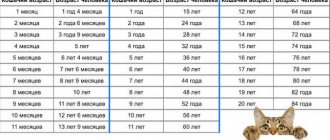Man has long tamed cats and dogs. Some pets live with us for quite a long time, others leave very quickly. Is it possible to extend the life of the furry members of our families and how to do it?
The lifespan of cats and dogs is influenced by various factors. The most important of them are the organization of nutrition and physical activity. During each life period, animals require a certain diet and activity level. To do this, you need not only to know exactly how old the cat or dog is, but also to understand how the pet’s age compares to human age.
Why does a person need to know the age of a pet?
Information about the age of a pet is needed in order to:
- Optimally distribute his physical activity;
- prevent illness in time and provide proper care to maintain the pet’s well-being;
- properly organize the diet and supplement it with the necessary vitamins and minerals;
- provide the pet with the necessary care;
- carry out vaccinations in a timely manner;
- understand when you can start mating or sterilize your pet.
Compliance with all these points will help provide the animal with the necessary conditions for a healthy existence and increase its lifespan.
What is the age ratio between a pet and a person?
Almost every cat or dog owner has asked this question at least once. It is impossible to accurately calculate the ratio of the age of a person and a pet, since the developmental characteristics and lifestyle of animals differ from human ones. But there are several ways to make at least an approximate calculation.
Unified calculation method for cats and dogs
One year of a pet's life is equal to seven years of a person - this method of calculation has been popular since the mid-20th century, and it is the same for cats and dogs. Scientists took the average age of a person (70 years) as a basis and divided it by 10. This is how the difference turned out to be 7 years.
Tables that will help you find out how old your pets are by human standards
Any owner of a cat or dog would like to know how many years his pet has lived by human standards. When can you say that your pet is in its prime, and when can it be considered old?
The normal lifespan of a dog is between 8-12 years. Very few dogs live to be 15 years old. As for cats, they live on average one and a half times longer than dogs.
The average life expectancy of cats is considered to be 12-15 years. However, modern domestic cats can live much longer due to good nutrition, proper care, comfortable living conditions and timely veterinary care.
A few decades ago, even domestic cats lived several times less. When does old age begin in cats? Experts say that after ten years, cats can already be called elderly.
If you gradually began to notice that over time your pet began to be more mischievous and demand more attention, perhaps he just got old and behaves like people in old age.
Below are tables for dogs and cats, from which you can determine what age your pet corresponds to by human standards.
Age of dogs by human standards
Age of cats by human standards
Long-lived record holders among animals
Both among people and among animals there are record holders for life expectancy. For example, this cat named Scooter from Texas lived for almost 30 years. The table does not even come close to matching this age by human standards.
Do you think this is an incredible amount for a cat? But no! A cat named Cream Puff from Texas lived in this world for a record 38 years and 3 days! They say that there was a cat in the UK that lived for 43 years, but this case has not been confirmed.
It is worth noting that Jacom Perry, the owner of Cream Puff, had another cat named Granpa Rex Allen, who also lived a very long time - 34 years and 2 months. Experts suggest that the secret to the longevity of these two cats lies in their special diet.
As was said at the beginning of the article, dogs live noticeably less, but among them there are real long-livers. The dog Bluey from Australia was born back in 1920 and spent 20 years on the pastures, helping his owner with grazing livestock. As a result, the dog lived 29 active years.
However, the animal's life expectancy record was recorded in 1975 - this year a cow named Modoc, who was born in Germany in 1896, died and arrived at a ranch in California at the age of two. In total, the cow lived about 78 years.
More touching stories about cats: ● A kitten that no one will ever hurt again. ● The children found a black something in the vacant lot, which turned out to be a dog. ● An old sick street cat turned into a real beauty. ● Wild cat: the story of how I spent the whole summer trying to gain the trust of a barn cat. ● Her dog was acting very strange. The woman did not understand that the animal was trying to save her!
Did you like the post? Share with your friends!
Source Based on materials
Click “ Like ” and get the best posts on Facebook from the page “It’s great with us!”
Share on Facebook VKontakte Twitter Odnoklassniki
Stages of a cat's maturation compared to human years
Each age period of cat development has its own characteristics:
- 0–6 months. At this time, the kitten is very actively developing and growing rapidly. The period corresponds to a person’s age from birth to 7.5 years.
- 7 months - 2 years. This is the period when the cat is growing up. By the age of 2, pets already know all the wisdom of life and turn into adult animals. In humans, this occurs from 8 to 25 years of age.
- 3–6 years. At this time cats are most active. They are behaviorally and physically mature, alert and healthy. In humans, this period corresponds to the age from 25 to 45 years.
- 7–10 years. If you properly care for and feed your cat, then during this period of its life it will lead the most active life. By human standards, this is approximately 45-55 years.
- 11–15 years old. At this time, cats become calmer, sleep more, and play less. Pets show the first signs of aging: vision deteriorates, the quality of fur and teeth changes. The appropriate age for a person is 60–75 years.
- 16 years or more. At this age, older cats need more careful care; they need to be given vitamins and quality nutrition. This way the pet will live safely for many years to come. In humans, this period corresponds to the age of 79 years or more.
Features of the development of dogs in comparison with humans
Dogs grow up differently. If we compare the stages of development of dogs and humans, we get the following picture:
- 0–1 month. By the age of one month, the puppy begins to actively explore the surrounding space. In this, he resembles a one-year-old child who is trying out many things. Such a baby knows no fear, and he needs care and constant supervision.
- 1–4 months. By the age of four months, an inquisitive puppy begins to be trained at the training ground. He begins to change teeth, like seven-year-old children, and he is just as careless and playful.
- 4–6 months. A dog at 6 months of age who is entering puberty can be compared to a 14-year-old teenager. The puppy's body grows unevenly, he has a childish perception of the world around him, and the dog's mood often changes.
- 6 months – 1 year. The age of 12 months for a dog corresponds to 16–18 years for a person. At this time the dog stops growing. She becomes more self-confident, males strive to establish leadership between their fellow tribesmen.
- 1–2 years. A two-year-old dog reaches the peak of its physical development, like a twenty-year-old person. Bitches at this time are already ready for motherhood. The dogs have already been trained in all commands.
- After five years. From this age, the dog begins to slowly age, like a forty-year-old person. The animal becomes more restrained and calm, it already has all the skills and knowledge for everyday life.
- 8 or more years. Dogs are entering their retirement period, that is, their bodies begin to age quickly. Similar changes occur in people aged 60–70 years. Dogs need to be given a more balanced diet and limited exercise.
Scientists have found an accurate way to convert a dog's age into human years
The lifespan of dogs depends on the breed
Photo: Dmitry AKHMADULLIN
There is a common belief among dog owners that one year of a dog's life is equal to seven years of a human's life. This popular theory is based on simple statistics: a dog's life span lasts about 10 years, and the average life expectancy for humans is about 70 years. But biologists know that the dynamics of age-related changes in humans and watchdogs are completely different. Until recently, there was no reliable way to look into the biological “passport” of a tailed friend.
However, a group of scientists led by Trey Idecker from the University of California at San Diego proposed a new strictly scientific calculation formula. To determine a dog's age, they used a mechanism known as the epigenetic clock. Over time, living organisms undergo a chemical modification of DNA: atoms of a methyl group are added to this molecule. They play the role of “grains of sand” in the biological “hourglass”. Based on the degree of accumulation of such chemical modifications, the exact age of the mammal can be diagnosed. Scientists knew how epigenetically the clock worked in humans. Trey Idek and his team have figured out how the genetic clock ticks in dogs.
The lifespan of dogs depends on the breed. Large dogs, such as mastiffs, leave for the land of eternal hunting after 6-7 years. And kids, like Chihuahuas, can get in the way for 17-18 years. American biologists used samples of 104 Labrador Retriever dogs (from puppyhood to 16 years) for the study. After studying the DNA of the dogs, scientists compared them with the genetic profiles of 320 people aged from 1 to 103 years.
Based on this analysis, a formula was compiled for determining the “human” age of dogs. It looks like this: Human age = 16 x ln (dog age) +31.
Don’t rush to panic; understanding this formula is easier than you think. There is only one character here that is not very familiar to the general public - this is the natural logarithm, which is denoted by the letters ln. You only need to do three fairly simple math steps.
1. The natural logarithm is calculated by pressing one button in an online calculator on the Internet. Click the ln button, then enter the number indicating the age of your dog. You can do it even simpler: type in the Yandex or Google search bar: natural logarithm of such and such a number. You will receive an answer instantly.
2. The number that was obtained after calculating the natural logarithm must be multiplied by 16.
3. Add 31 to the resulting product. The final amount will indicate the number of years the dog has lived in human years.
Example: let’s say your watchdog is 4.5 years old. The natural logarithm of 4.5 is 1.504. We multiply this number by 16 and add 31. As a result, Barbos turned 55 full human years and he has long experienced what a midlife crisis is.
This formula is ideal for determining many of the dog's life milestones. For example, the age of 7 weeks in dogs closely corresponds to the 9-month period in humans, at which time puppies and infants cut their baby teeth. And the age of 12 years in Labradors is equal to the 70th birthday in humans. But some physiological periods between these epochal milestones do not coincide so well. In particular, dogs reach puberty much faster and generally mature very quickly. The hands of the genetic clock at the age of 1 year in dogs show the same “time” as in a person at the age of 31 years. However, in the second half of life, the accumulation of chemical modifications of DNA in dogs slows down and people catch up with their pets. As follows from the study, having rapidly reached old age, dogs no longer age as quickly as we do (see table). In any case, this method of determining age more accurately reflects the biological age of the dog than simply multiplying by seven.
What is the approximate age relationship between a dog and its owner?
Photo: Nail VALIULIN











